A human-centred approach to strategy
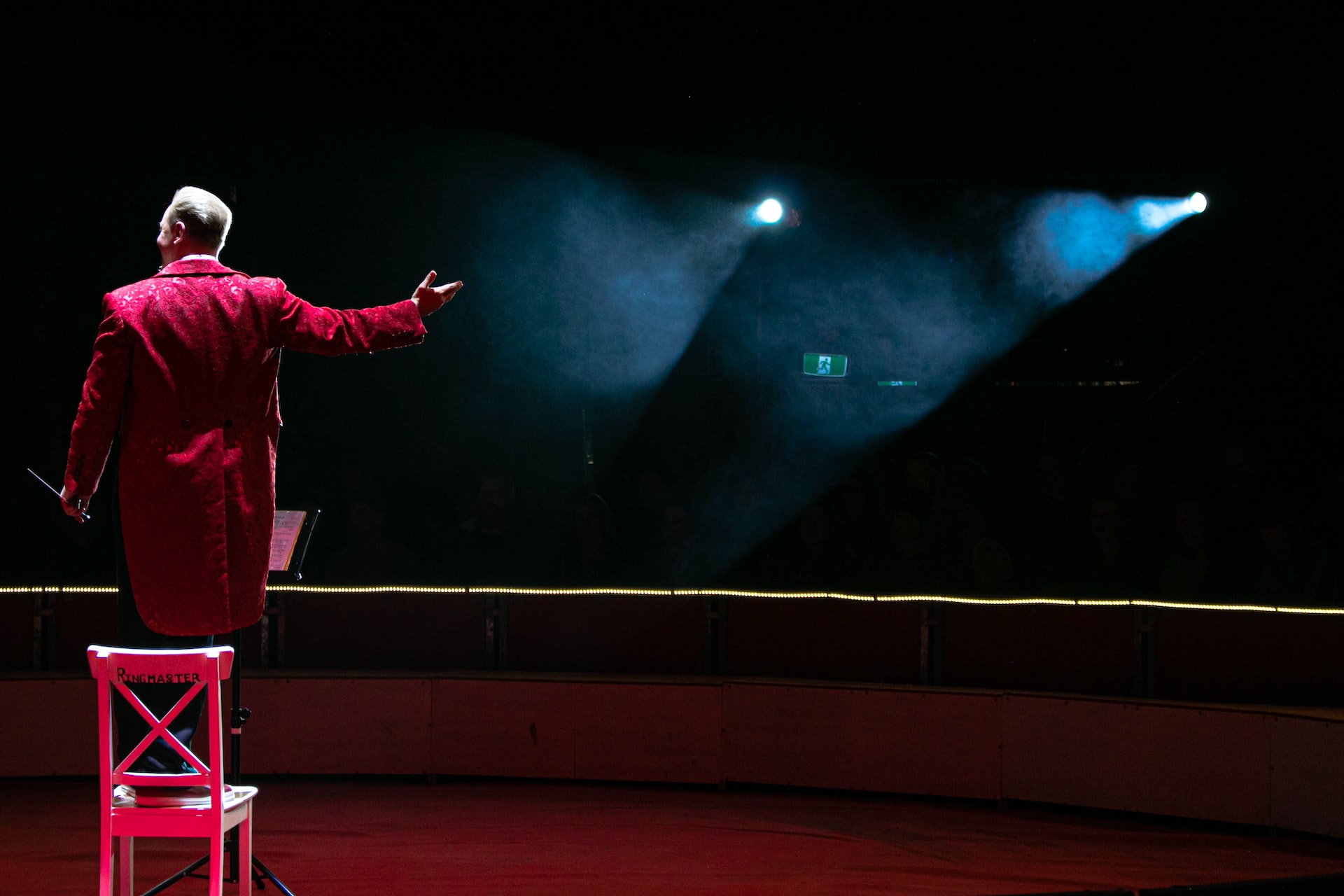

Strategies can no longer be set from the top and expected to be successful. They need to engage at every level and to do that, you need a Human-Centred approach.
Developing, designing, and implementing strategies isn’t new. People have been reviewing what they’re doing and where they want to go since the cave man era. While then it was more tactics than strategies, these moves helped to progress civilisation.
Today, our organisational strategies and how we implement them has never been more important. The world continues to evolve and making your company stand out from the crowd is critical. Unfortunately, there just isn’t space for every company to grow and therefore having the right strategy that differentiates you from your peers will get you one step closer to your goals.
Let’s go deeper into this with Rosie and her Circus, Circus de Soil; an up-and-coming circus in Melbourne. They offer their audiences amazing acrobatics, to beautiful music that wows the crowd every time. They have goals of expanding from their local area and travelling Australia and eventually the world. The circus industry is in a challenging position, with great circuses being incredibly successful but only a small number make it. To be successful, Rosie needs a great strategy.
A great strategy sets clear direction on what to focus on, informs your people and your team about where to spend their effort, and motivates your people to achieve great things.
Back in the day it would have been ok for Rosie as the Ring Master to set the strategy. However, strategies can no longer be set from the top and expected to be successful. They need to engage at every level and to do that, you need a Human-Centred approach.
The building blocks of strategy
Before we begin, there are a few basic building blocks we need to know. A strategy is nothing without an understanding of why you’re doing it and where you’re going. This is your organisation’s purpose, mission and vision. Each of these elements plays a role in guiding where you focus and what your strategy will look like.
In simple terms:
Your purpose: Why your company exists
Your vision: Where you want to get to by a specific point in time
Your mission: What bold moves you need to take to achieve your vision
Your values: How you behave as a company, the attitudes and behaviours you display
Your Positioning: How all of the above is viewed to occupy a space in people’s minds
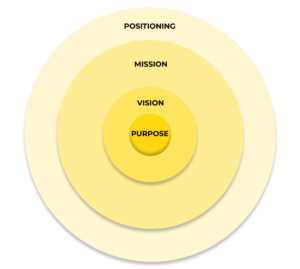
We start by ensuring that these resonate with your team as they are the common thread across departments and individuals. Having a clear purpose, vision, and mission is our anchor and our strategy is the guide that will help us achieve these goals. It ensures we are making the right business decisions along the way to get there. Everything is connected.
To develop your unique strategy, we break it down:
- Understanding the problem,
- Designing impactful solutions and
- Making it stick.
For Rosie, their purpose is to make the world a better place through performance; their vision is to activate the imagination, activate the senses and activate the emotions of people around the world; their mission to, through outstanding performance, become the best-known circus in Australia. These may be great on paper, but they need to be clear across her team. Everyone from the performers, ticket sales, backstage, costumes, set design to the servers need to be clear before we can start to successfully embed our strategy.
Having a holistic view of the organisation and its current operations is therefore essential, and Human-Centred Design (HCD) is brilliant at bringing this to life. Gathering information from a variety of different sources and conducting research, we want to really understand the organisation and its environmental context and develop a proposition for success.
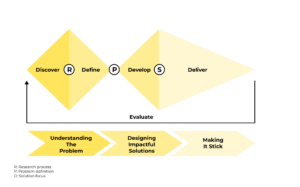
Understanding the problem
We start by conducting research, to understand what’s going on; looking at the market trends, and the competitive environment the organisation is in. This will give us extensive knowledge into the business, but this is just the beginning.
Working with Rosie, there were several factors to consider: market trends is a great starting point with understanding: what were customers looking for in their circus? What are other circuses doing? Who is successful, who isn’t, and why? Let’s also expand this out to broader entertainment – what are children doing in their school holidays? What performances are adults going to? What are people watching on YouTube and reels, what gets attention and what aligns with the purpose of our circus. Looking at best practice globally, to start to generate the picture of the environmental context of Circus de Soil.
Making your strategy successful is about your people – at all layers of the organisation. We will talk with the board, the executive team, leaders within the organisation and people who work there. Providing us with real information on what’s working, what isn’t, what they love about the organisation and behaviours and traits that aren’t serving them, we ask also about their ideas for success. It’s important to do this in a variety of different ways, surveys, 1:1 interviews, focus groups – each format provides a different experience and different insights that are shared.
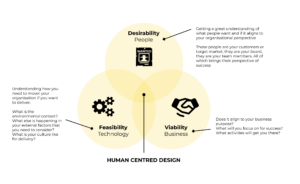
At Circus de Soil, their people are a big part of their success and so interviewing everyone from the Ring Master to the coaches and trainers, the performers, every person in the chain is essential. Great insights were heard on where the performers thought they could try new tricks, and where the food service thought they loved what they saw but they weren’t valued because they weren’t performers and so had been disengaged lately, where the board was excited but nervous around the investment and what the pay back period would be. Each of these perspectives painted the picture of the where the circus really was today, its strengths and opportunities and if we are to lead all the different elements to reach these goals what we need to solve for.
Bringing this people lens to your strategy sets you up for success, after all they are the ones who will be implementing it, whether through their daily activities or projects. With the information, we synthesise all the data to form insights. Developing a strategy which considers the whole picture is essential.
Creating impactful solutions
With insights formed and the environmental context understood, we test and challenge different strategic solutions. Considering where you are today, where you want to be and how we can bring your people along the journey, we form your strategy. With key statements to provide focus, engagement and direction, they form your strategic intent. They should be clear, easy to understand and relatable. When done well, your team should be able to see their insights coming to life and the how the purpose will be delivered.
These strategic statements become the pillars of your organisation for the next 3-5 years. The activities that then align underneath them are your projects and will change over time as your company grows and gets closer to achieving those goals. These projects will deliver the experiences that you want to create for your customers.
Rosie brought together the insights and developed 3 strategic intent statements to guide and motivate her team. Giving them a direction and focus, they were:
- To build a relationship through performance with every individual in Australia, creating a focus for growth
- Be global, act local, enabling them to keep their minds on the bigger picture, while supporting local communities, reducing their environmental impact and minimising costs
- Empower our people to perform no matter what their role, providing their team with the voice to change the way the company works
Most organisations have more projects than resources to complete them. The strategic intent provides direction and focus, through aligning activities under the statements and then prioritising which of your activities will get you there faster, with better quality and are unique to you supporting your goals. These projects bring your strategy to life.
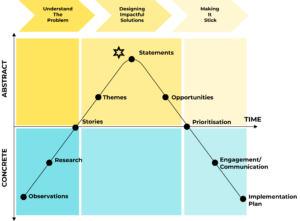
Making it stick
With a clear understanding of why, where, and what, we focus on the how. How is about engaging our people because at the end of the day, every person in the organisation is going to be critical to make it happen. ‘How’ is our values, ‘how’ is our change management and transition plan. These components are integral to making it stick.
Some of the insights you have formed from the interviews may not have gone into the strategy but instead have provided useful information that feeds your change management for implementing your strategy.
How are you going to communicate it? Where do you need to change the culture or behaviours to implement your plans? Your implementation plan should look at every aspect and incorporate these ideas into how you will communicate, engage, and deploy.
Strategy can often be abstract to many people in the organisation. Your change plan should incorporate how to communicate it to them in a manner that makes sense and connects the work that they do back to the organisations overall purpose, mission and strategy. We look at different ways that engage your people to respond and interact with the strategy, making it real for them and linking it back to purpose and customers.
Using HCD, we ideate different ways to deliver and engage. Continuously testing, learning, and iterating on the approach for implementation.
For Rosie the engagement needed to be high, she needed to link the actions back to what she had seen and heard from her interviews, and workshops. She wanted to think differently and engage her team so they were all motivated and felt engaged through the process.
She worked with a few of her performers and created a video talking through the strategy, showing visuals, linking back to what they had heard to what they were doing and creating a performance that would resonate and remind her team when they saw it of what they were trying to achieve. This was her version of brining it to life, distinct for her environment. Support her team to embed the behaviours and set her strategy up to differentiate Circus de Soil from the rest.
The final piece of this puzzle is accountability through measurement. Strategy is not just set and forget, you need to have a continuous feedback loop on what you are delivering, how it is progressing and being able to review subjectively to iterate, fast track and stop projects and operational activities as necessary to ensure that you’re strategy and therefore your organisation is a success and delivering to your purpose.
Flow diagram showing different elements of change management to make it stick
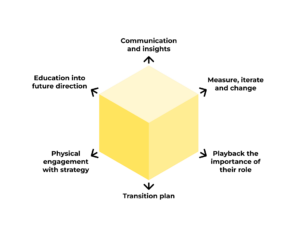
At Three6, no matter your organisation type (from circus to not-for-profit), we look at all these elements and bring it together so that you have a strategy that leads you to your unique goals and growth ambitions.
Want to have a chat? Contact us below or email us at hello@three6.com.au
